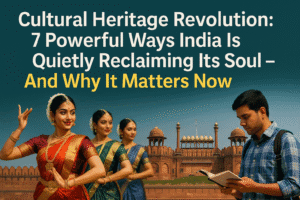Cultural Heritage Revolution: 7 Powerful Ways India Is Quietly Reclaiming Its Soul – And Why It Matters Now
India’s cultural heritage revival is undergoing a quiet yet powerful transformation, far beyond the surface of monuments and festivals. Through strategic global cultural diplomacy, the government is building long-term intercultural bridges with 41 nations, while strengthening national unity with domestic initiatives like Yuva Sangam and Kashi Tamil Sangam. The Archaeological Survey of India’s digital push is preserving not just physical sites but historical memory itself. Hands-on efforts like the Vilupt Lok Mahotsav are reviving endangered art forms by reconnecting them with new generations.
Meanwhile, platforms like the Amrit Kaal website humanize history with user-contributed stories, multimedia content, and a spotlight on unsung heroes. These efforts emphasize culture as a living force – one that empowers citizens, connects communities, and deepens national identity. Preservation here is not about nostalgia, but about creative continuity and inclusive pride. The success of this cultural revolution lies not in statistics but in the everyday acts of rediscovery and participation across India.

Cultural Heritage Revolution: 7 Powerful Ways India Is Quietly Reclaiming Its Soul – And Why It Matters Now
The Indian government’s efforts to preserve and promote cultural heritage often get reduced to tourist-friendly headlines. But a closer look at recent initiatives, detailed by Union Minister Gajendra Singh Shekhawat, reveals a far more profound, multi-layered strategy – a concerted push to weave India’s living cultural tapestry back into the national consciousness and global identity. This isn’t just about showcasing dance forms; it’s about safeguarding the nation’s soul.
Building Bridges, Not Just Stages
- Global Cultural Diplomacy: Signing Cultural Exchange Programmes (CEPs) with 41 countries since 2021 moves beyond simple performances. It’s strategic soft power, fostering deep intercultural dialogue in diverse fields – from museum science and monument conservation to literature and anthropology. Events like the Festivals of India in Kuwait (2023) and France (2023) are crucial platforms, but the real impact lies in the sustained partnerships built through these CEPs, fostering mutual understanding and respect.
Guardians of Stone and Story
- Conserving Our Physical Legacy: The Archaeological Survey of India (ASI) faces the monumental task of preserving thousands of sites. Beyond essential maintenance and conservation guided by national policy, the push for digital documentation and condition mapping is a game-changer. This creates vital, searchable archives for future generations, ensuring knowledge isn’t lost even as stones weather. The new museum at Delhi’s Red Fort, dedicated solely to the ‘Aazadi-ke-Diwane’ (Unsung Heroes of the Freedom Struggle), exemplifies a shift towards honouring the people within the history, not just the structures they inhabited.
Rekindling Roots: From Vilupt Lok to Yuva Sangam
- Rescuing Endangered Arts: The Vilupt Lok Evam Janjatiya Kala Utthan Mahotsav (Oct 2024 – Mar 2025) wasn’t just another festival. Its divisional-level, intensive 15-21 day workshops across seven zones, in collaboration with textiles ministries, states, and academics, provided immersive training. This hands-on approach is vital for reviving art forms teetering on the edge of extinction, transmitting skills directly to new practitioners.
- Connecting India to India: Programs like Yuva Sangam (youth exchange between paired states) and Kashi Tamil Sangam (cultural dialogue between Kashi and Tamil Nadu) tackle a critical modern challenge: cultural disconnect within the country. By facilitating direct experiences and exchanges, they foster national unity built on appreciation of diversity, moving beyond superficial stereotypes. These are investments in shared cultural literacy for the next generation.
Digitizing Memory: Making History Accessible, Not Archival
- The Amrit Kaal Digital Revolution: The transition of the Azadi Ka Amrit Mahotsav website to Amrit Kaal (https://amritkaal.nic.in/) represents a massive leap in democratizing history. Its ‘Freedom Struggle’ section isn’t a static archive; it’s a dynamic, multifaceted platform:
- Humanizing History: The “Unsung Heroes” and “Digital District Repository” sections actively recover lost narratives, shifting focus from a few leaders to the countless individuals and local movements that shaped the nation.
- Citizen Participation: The “Public Contribution Portal” transforms the public from passive consumers to active contributors, enriching the historical record with personal and community stories.
- Multi-Sensory Engagement: “Swatantra Swar” (revolutionary poetry recitals), podcasts, “Rajyageet” (state anthems), and online exhibitions use diverse media to make history resonate emotionally and intellectually. This democratizes access for researchers, students, and curious citizens alike.
The Underlying Vision: More Than Tourism
This comprehensive approach signals a crucial understanding: cultural heritage isn’t merely a commodity for tourism or nostalgic reverence. It’s the living bedrock of national identity, resilience, and creativity.
- Preservation as Continuity: Saving vanishing art forms and languages isn’t about freezing the past; it’s about preserving unique ways of seeing and expressing the world, enriching the present and future.
- History as Empowerment: Recovering and sharing the stories of unsung heroes and local struggles empowers citizens, particularly youth, with a deeper, more inclusive understanding of their nation’s journey and their place within it.
- Culture as Connection: Domestic exchange programs and international CEPs recognize culture as the ultimate bridge – between generations, regions, and nations – fostering empathy and shared humanity.
The Real Measure of Success: The true impact won’t be just in visitor numbers to monuments or festival attendances, but in whether a young person in a remote village feels pride in reviving a fading craft, whether citizens actively contribute their family’s freedom stories online, and whether Indians across states develop a genuine curiosity about each other’s traditions. It’s in embedding cultural consciousness into the fabric of everyday life, ensuring India’s ancient soul thrives vibrantly in the modern world. This is the quiet, essential work of safeguarding a civilization’s heartbeat.
You must be logged in to post a comment.